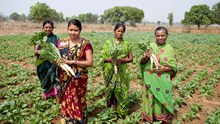
Sesame is a valuable oilseed crop in Punjab, appreciated for its high oil content, nutritional value, and adaptability to varied climatic conditions. It plays an important role in meeting domestic demand and supporting India’s export potential. Despite its benefits, sesame cultivation faces challenges such as soil fertility issues, pest infestations, and unpredictable weather patterns. To overcome these challenges and enhance productivity, Punjab’s farmers can adopt improved varieties and follow scientifically proven agronomic practices.
Recommended Sesame Varieties for Punjab
Several sesame varieties have been developed specifically for Punjab’s agro-climatic conditions. These varieties not only provide higher yields but also possess traits such as better oil content, early maturity, and disease resistance.
Punjab Til-1 (1966)
One of the earliest varieties introduced, Punjab Til-1 is a white-seeded type known for its early maturity. It typically yields between 650 and 700 kg/ha and contains 48–52% oil. Its adaptability and short growing cycle make it a reliable choice for many farmers.
TC-25 (1978)
Another strong performer, TC-25 offers slightly higher yields ranging from 700 to 800 kg/ha, with a high oil content of 50–52%. Like Punjab Til-1, it matures in about 80 to 85 days and is well-suited to Punjab’s conditions.
TC-289 (1986)
Introduced later, TC-289 is notable for its tolerance to Macrophomina, a soil-borne pathogen that causes root rot. It yields similarly to TC-25 and has a slightly longer maturity period of 84 to 88 days. This variety, along with the others, shares the desirable white seed trait and shows good adaptability to local environments.
Best Agronomic Practices for Improved Yield
Maximizing sesame productivity in Punjab requires a combination of timely operations, appropriate input management, and vigilant crop care.
Land Preparation
Land preparation is a critical first step. Deep plowing during the summer improves soil structure and drainage, while subsequent harrowing and leveling help achieve a fine tilth, reducing the risk of waterlogging. Incorporating 5 to 10 tons per hectare of well-decomposed farmyard manure before sowing boosts soil fertility and organic matter content.
Sowing
Sowing should ideally take place in the second fortnight of July to align with the Kharif season. Line sowing, with a seed rate of 2.5 to 3 kg/ha, is more efficient and manageable compared to broadcasting, which requires about 5 kg/ha. Spacing plants at 30 x 15 cm or 45 x 10 cm encourages better light penetration and air circulation, enhancing plant health. Treating seeds before sowing—using a mixture of Thiram (2 g/kg) and Carbendazim (1 g/kg), or Trichoderma viride (5 g/kg)—can significantly reduce fungal infections.
Nutrient Management
In terms of nutrient management, applying 40 kg/ha of nitrogen, 20 kg/ha of phosphorus, and 20 kg/ha of potassium (especially in irrigated fields) supports healthy crop development. Sulfur application at 15 to 20 kg/ha is also crucial, as it directly contributes to increased oil content in the seeds. It is advisable to apply half of the nitrogen along with the full dose of phosphorus and potassium at the time of sowing, and the remaining nitrogen during the flowering stage (30–35 days after sowing).
Weed Control
Weed control is essential, particularly during the first 40 days when sesame is highly susceptible to competition. Two hand weedings—once around 15–20 days and again at 30–35 days after sowing—are effective. A pre-emergence application of Pendimethalin at 1 kg active ingredient per hectare can further suppress weed emergence.
While sesame is predominantly grown under rainfed conditions in Punjab, irrigation during critical stages such as flowering and capsule formation can be highly beneficial. However, waterlogging must be strictly avoided, as the crop is sensitive to excess moisture.
Pest and Disease Management
Effective pest and disease management is another key component. Common pests include leaf rollers, capsule borers, gall flies, and jassids, while major diseases include Phytophthora blight, Macrophomina root rot, bacterial leaf spot, powdery mildew, and phyllody. The use of resistant varieties, along with timely applications of recommended insecticides and fungicides, helps safeguard crop health.
Harvesting
Harvesting should begin when the lower seed capsules turn yellow and the plant’s leaves start to droop. Delaying harvest increases the risk of seed shattering. After cutting, plants should be thoroughly dried before threshing to preserve seed quality and minimize post-harvest losses.
Quality Attributes of Sesame Varieties in Punjab
|
Variety |
Seed yield (kg/ha) |
Oil content (%) |
Days to Maturity |
Salient Features |
|
Punjab Til - 1 |
650-700 |
48-52 |
80-85 |
white seeds, early maturing, adapted to Punjab climate |
|
TC-25 |
700-800 |
50-52 |
80-85 |
white seeds, high oil, content, well suited for Punjab |
|
TC-289 |
700-800 |
48-52 |
84-88 |
white seeds, tolerant to macrophomina, perform well in Punjab |
Sesame cultivation in Punjab holds immense promise for both local consumption and export markets. With scientifically developed varieties like Punjab Til-1, TC-25, and TC-289, and the implementation of best agronomic practices, farmers can significantly boost yield and seed quality. These improvements not only enhance profitability but also promote sustainable agricultural practices.
As global demand for sesame continues to rise, adopting modern cultivation techniques positions Punjab’s farmers to play a larger role in India’s sesame trade, unlocking new economic opportunities and strengthening the state’s agricultural landscape.
















